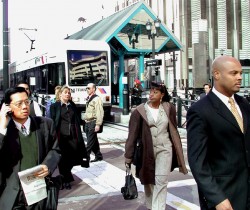Higher gas prices, of course, mean winners and losers in the job market. The winners are likely to include some oil company employers, alternative-energy employers, Houston recruiters, and telecommuters. It’ll be interesting to see whether the increased demand for public transportation will eventually mean more hiring at public transportation agencies.
Here in sprawling Los Angeles, though the Bel Air/Beverly Hills elite continues to incorrectly claim that “no one in LA takes public transportation,” the MTA says that “Metro Rail ridership in May shot up 6 percent over May 2007, one of the highest one-month spikes on record.”
In May, more than 7.6 million passengers boarded the MTA’s two Los Angeles subway lines and three light-rail surface lines. The organization employs about 10,000 people, and is hiring engineers, Oracle programmers, and others.
In Chicago, the transit authority is hiring accountants, attorneys, database administrators, and, among other jobs, someone to collect intelligence on terrorism. Challenger, Gray, and Christmas says that the number of first-quarter Chicago passengers increased 5.7% from last year to a record 20.7 million.
Boston-area ridership is up 5-6% over last year.
Light rail use – such as a trolley — is way up in Baltimore, Minneapolis, St. Louis, and San Francisco. Meanwhile, use of heavy rail is up sharply in Staten Island. Bus ridership is booming in San Antonio and Denver. In the Seattle area, Sound Transit’s Bruce Gray tells me that hiring will particularly pick up if a ballot measure passes expanding the area’s transportation system. And Morgan Lyons of Dallas Area Rapid Transit tells me the agency will be hiring aggressively as the light rail system expands from 45 to 90 miles through 2013.
Public-transportation payrolls are sometimes set in stone through an annual budgeting process. In other words, if gas prices go up today, that doesn’t mean hiring goes up tomorrow. But I bet public-transportation employers will argue for increased staff as soon as they can get it.
Virginia Miller, a spokeswoman for the American Public Transportation Association, says that trends in public transportation are reversing itself in the sense that 50 years ago, there was rapid movement the other direction — from streetcars to cars. “There’s a demand like we’ve never seen, a sea changing going on,” she says. “It’s like back to the future.”